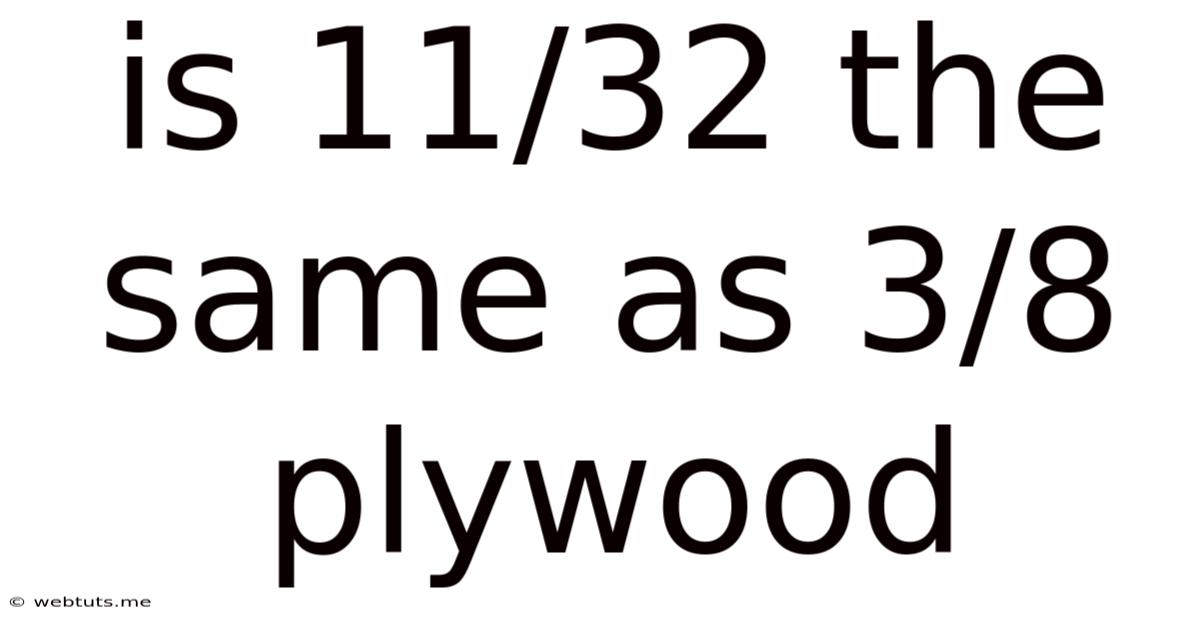Is 11/32 The Same As 3/8 Plywood
Webtuts
May 09, 2025 · 4 min read

Table of Contents
Is 11/32 the Same as 3/8 Plywood? A Comprehensive Guide
The question, "Is 11/32 the same as 3/8 plywood?" is a common one, particularly among DIY enthusiasts and construction professionals. While seemingly a simple query, the answer requires a deeper understanding of wood thickness, measurement precision, and manufacturing tolerances. This article delves into the intricacies of plywood thickness, exploring the subtle differences and practical implications of choosing between 11/32" and 3/8" plywood.
Understanding Plywood Thickness: Fractions and Decimal Equivalents
Plywood thickness is typically expressed as a fraction of an inch (e.g., 3/8", 1/2", 5/8"). However, manufacturing processes and measurement variations mean the actual thickness can deviate slightly from the nominal value. This is where the confusion around 11/32" and 3/8" arises.
Let's convert these fractions to decimal equivalents for a clearer comparison:
- 3/8 inch = 0.375 inch
- 11/32 inch = 0.34375 inch
The difference might seem negligible at first glance – just 0.03125 inches. But in construction and woodworking, even small discrepancies can have significant consequences.
Manufacturing Tolerances: The Key to Understanding the Discrepancy
Plywood manufacturers work within specific tolerances. This means the actual thickness of a piece of plywood can vary slightly from the stated nominal thickness. These tolerances are usually expressed as a plus or minus range. For example, a piece of plywood labeled 3/8" might actually measure anywhere within the manufacturer's tolerance range, which could include thicknesses slightly above or below 0.375". This tolerance accounts for variations in the manufacturing process and the properties of the wood itself.
It's important to note that not all manufacturers adhere to the same tolerances. Some might have tighter tolerances than others, leading to more consistent thickness. Always check the manufacturer's specifications to understand the expected variation.
Practical Implications of the Difference
While the difference between 11/32" and 3/8" plywood might appear insignificant, it can lead to issues in certain applications:
1. Cabinetry and Fine Woodworking
In applications demanding precise fit and finish, such as cabinetry or fine furniture making, even a slight difference in thickness can be problematic. Using 11/32" plywood where 3/8" is specified could result in gaps or misalignments, requiring additional adjustments or potentially compromising the structural integrity of the project. The accumulated difference across multiple layers could be significant. Sticking to the specified thickness is crucial for achieving a professional and accurate result.
2. Flooring and Subflooring
For flooring applications, the difference could affect the overall levelness of the floor. Consistent thickness is paramount to ensure proper support and prevent uneven surfaces. Using a thinner plywood, such as 11/32", in place of 3/8" might lead to flexing or instability over time, especially under heavy loads. Additionally, slight inconsistencies in thickness can make the installation more difficult, leading to a less professional finish.
3. Wall Paneling and Sheathing
In wall paneling or sheathing applications, the subtle difference in thickness may not always be critical. However, consistent thickness ensures proper alignment and ease of installation. Using a mix of 11/32" and 3/8" plywood could lead to uneven surfaces and complicate finishing. Furthermore, this discrepancy might interfere with the proper alignment of other structural components, creating issues with doors or windows.
4. Structural Applications
For structural applications, the cumulative effect of even slight thickness differences becomes more significant. The structural integrity of the project depends on the accurate dimensions of the plywood sheets. Using a thinner plywood might not provide the required strength or stiffness, especially under load-bearing conditions, potentially leading to structural failure. Always comply with building codes and specifications for structural components.
How to Choose the Right Thickness
When choosing between 11/32" and 3/8" plywood, consider the following factors:
- Project Requirements: The most crucial factor is the specific requirements of your project. Refer to the plans or specifications to determine the exact thickness needed. If it states 3/8", use 3/8".
- Manufacturer's Specifications: Check the manufacturer's tolerances for the plywood. Understanding the possible variation will help you manage expectations.
- Measurement: Always measure the plywood yourself before starting your project. This will help you understand the actual thickness and make necessary adjustments.
- Application: The intended use of the plywood will also influence the choice. For critical applications requiring precision, it's best to stick to the specified thickness.
- Availability: The availability of the specified thickness in your local area might also play a role. If 3/8" is unavailable, you might need to consider the implications of using 11/32".
Conclusion: Are they interchangeable? Usually, no.
While the numerical difference between 11/32" and 3/8" plywood might appear small, the practical implications can be significant, depending on the application. They are not directly interchangeable in most scenarios. Always prioritize using the specified thickness mentioned in your project plans or specifications. Failing to do so could compromise the quality, functionality, and potentially the structural integrity of your project. Accurate measurements and a thorough understanding of manufacturing tolerances are essential for successful woodworking and construction projects. The seemingly minor difference in thickness can make a considerable impact on your final outcome. Accurate material selection is key to avoiding costly mistakes and ensuring a satisfying project. When in doubt, always consult with a professional.
Latest Posts
Latest Posts
-
How Many More Days Until October 16
May 09, 2025
-
50 Quarts Equals How Many Cubic Feet
May 09, 2025
-
How Tall Is 190 Cm In Inches
May 09, 2025
-
How Many Oz Is 10 Cups Of Water
May 09, 2025
-
How Long Does It Take To Mow Lawn
May 09, 2025
Related Post
Thank you for visiting our website which covers about Is 11/32 The Same As 3/8 Plywood . We hope the information provided has been useful to you. Feel free to contact us if you have any questions or need further assistance. See you next time and don't miss to bookmark.